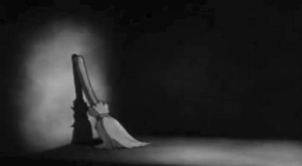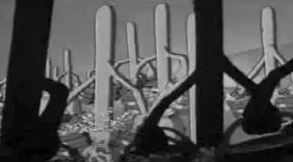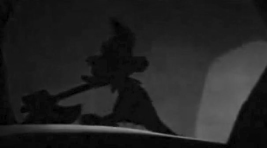by Jane Sojin Kim
Animation as an art form is quite mind-blowing in terms of how it influences our collective unconscious. I believe that there is a deep symbolic root in animation: each movement and speech sound in animation is the (un)conscious reflection of the artist who has been interwoven within it whether s/he realizes or not. Out of repetitive inanimate lines, a visceral movement is achieved at the end. The nature of animation itself is an illusion full of magic.
I was one of those kids obsessed with Walt Disney’s animations. I can still vividly remember every visual moment and dialogue in each and every Disney film. Recently, I had a chance to watch Disney’s Fantasia: Sorcerer’s Apprentice (1940) for the first time in twenty years. As I watched it I realized that the film reveals symbolic representations of the United States in the 1940s. I want to share some of the hidden messages that I wasn’t conscious of when I watched Fantasia as a kid.
In “The Sorcerer’s Apprentice” segment of Fantasia, Mickey Mouse ventures through a surrealist dream. Abstract symbols like brooms, water, and Mickey’s outfit seem to represent one familiar landscape—women’s roles in 1940s America. Mickey wears a red gown and a blue hat with stars which seem to signify the American flag (as shown in Figure 1).
 Figure 1: Mickey Mouse’s outfit resembles the U.S. flag. Fantasia (1940).
Figure 1: Mickey Mouse’s outfit resembles the U.S. flag. Fantasia (1940).
His temporary authority as a sorcerer allows him to put a spell on a broom (a domesticated object) to do the tedious labor of lifting water from one place to another. As shown in Figure 2, the shadow of the broom has a feminine silhouette with a curved waistline.
 Figure 2: The broom is untouched as if it was waiting for
Figure 2: The broom is untouched as if it was waiting for
someone. Fantasia (1940).
This is a possible social facsimile of the 1940s where women had joined the military (in noncombat roles) and worked in civilian jobs. Mickey eventually kills the broom by chopping its head into pieces. The obliterated remnants duplicate into hundreds of other brooms and the labor becomes uncontrollable as if the brooms are not willing to relinquish this newfound independence, like the women of the 40s.
The portrayed symbols are not mere accidents, but are the social subconscious of the dreamer. Walt Disney lived in the U.S. during the war; Disney’s role as a social witness might have been transferred into the transparent screen as abstract, yet powerful movements of a mouse.
 Figure 3: The balance of power rests in the hands of the brooms as if
Figure 3: The balance of power rests in the hands of the brooms as if
they are manipulating the machinery of war. Their movement is mechanized but almost like a march. Fantasia (1940).
There is a dream-like quality in Fantasia, where the ego is revealed. Fantasia takes place in an isolated underground. The locality lacks lighting yet it provides rich shadows, often in their overwhelming presence (as shown in Figure 4). It engenders an uncanny effect as if the suppressed alter-ego of Mickey Mouse and that of the broom surge into the space with a quiet shriek.
 Figure 4: Shadow plays an overwhelming entity, often larger than
Figure 4: Shadow plays an overwhelming entity, often larger than
the characters. Fantasia (1940).
Representing the contrast (black and white) the shadow implies the Jungian aspect of “the unconscious aspect of mind”. Fighting between the real and the ego, shadow acts as a grey area, where the mixture of black and white, good and evil are intertwined. Fantasia seems to portray the good and evil (there is no in-between). Akin to the hidden alter-ego, shadow is most notable in a scene when Mickey chops the
head off the broom with an axe (Figure 5). The violent scene is not shown yet the shadow elucidates the sin of the “innocent” mouse.
 Fig. 5. Shadow is shown as Mickey commits a violent act. The cleared
Fig. 5. Shadow is shown as Mickey commits a violent act. The cleared
defined shadow, harsh textures and crisp edges produce a sense of
suspense of the enemy within. Fantasia (1940).
Here is a link to the film:
http://www.youtube.com/watch?v=Ait_Fs6UQhQ&feature=fvst
What are your thoughts on this? I’d love to hear about the “hidden” visual metaphors unconsciously embedded in the film…
